Characteristics 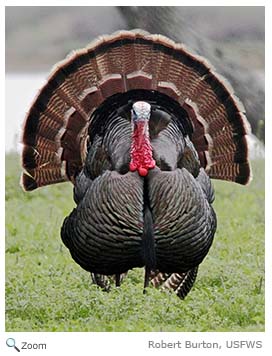 The wild turkey is a large ground-dwelling bird that is 36-44 inches in length. It has a large, fan-shaped tail; long, stocky pink or gray legs; short, rounded wings; a bare head and neck and a small, down curving bill. The wild turkey has
iridescent bronze body feathers and black and white bars on its wings. The wild turkey is a large ground-dwelling bird that is 36-44 inches in length. It has a large, fan-shaped tail; long, stocky pink or gray legs; short, rounded wings; a bare head and neck and a small, down curving bill. The wild turkey has
iridescent bronze body feathers and black and white bars on its wings.
The male wild turkey has a tuft of feathers called a beard on his chest and an upwardly curving spur on his lower legs. His breast feathers are tipped with black and he has a bluish-gray neck and a red wattle (a fleshy lobe of skin that hangs from the neck or chin.) The male's bare head and neck is red, blue or white depending on the season!
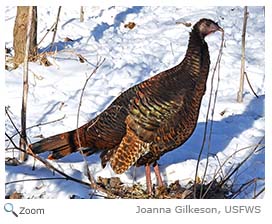 The female's breast feathers are tipped with brown, white or gray. She doesn't have spurs and she usually doesn't have a beard. she has a gray head and a feathered neck.
Males are usually larger than females. In the east, the tip of the turkey's tail is brown. In the Southwest the tail tip is white. The wild turkey's call is a gobble! The female's breast feathers are tipped with brown, white or gray. She doesn't have spurs and she usually doesn't have a beard. she has a gray head and a feathered neck.
Males are usually larger than females. In the east, the tip of the turkey's tail is brown. In the Southwest the tail tip is white. The wild turkey's call is a gobble!
Range
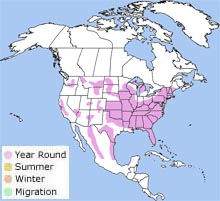 The wild turkey can be found throughout the eastern United States from extreme southern Canada south to northern Mexico and east to Arizona. It is also found in isolated pockets in some western states, where it has been introduced. The wild turkey can be found throughout the eastern United States from extreme southern Canada south to northern Mexico and east to Arizona. It is also found in isolated pockets in some western states, where it has been introduced.
Habitat
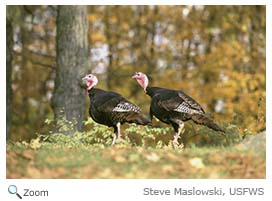 The wild turkey lives in hardwood and mixed conifer-hardwood forests with openings like fields, pastures, orchards and marshes. The wild turkey lives in hardwood and mixed conifer-hardwood forests with openings like fields, pastures, orchards and marshes.
|
|
Diet
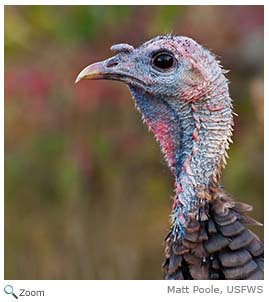 The wild turkey is an omnivore. It eats acorns, nuts, seeds, fruits, insects, buds fern fronds and salamanders. It usually forages on the ground in flocks, scratching in the earth to uncover food. The wild turkey feeds during the day. It roosts in trees at night. The wild turkey is an omnivore. It eats acorns, nuts, seeds, fruits, insects, buds fern fronds and salamanders. It usually forages on the ground in flocks, scratching in the earth to uncover food. The wild turkey feeds during the day. It roosts in trees at night.
Life Cycle
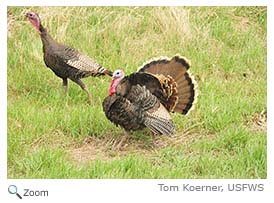 Wild turkeys mate in the early spring. The male wild turkey gobbles to attract a female. He fans out his tail, struts around the female and lowers his wings and drags the tips on the ground. The male's gobble is so loud it can often be heard a mile away! The male mates with more than one female. Wild turkeys mate in the early spring. The male wild turkey gobbles to attract a female. He fans out his tail, struts around the female and lowers his wings and drags the tips on the ground. The male's gobble is so loud it can often be heard a mile away! The male mates with more than one female.
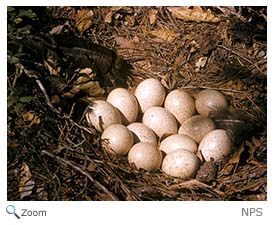 The female lays 8-15 buff-colored eggs in shallow depression on the ground that is hidden by brush, grass, vines or other vegetation. She incubates the eggs for 25-31 days. The chicks or poults are covered with down at birth and leave the nest shortly after hatching. The chicks are
precocial and feed themselves shortly after birth. The male poults stay with their mother through the fall. Female poults remain with their mother until the nest spring. The female lays 8-15 buff-colored eggs in shallow depression on the ground that is hidden by brush, grass, vines or other vegetation. She incubates the eggs for 25-31 days. The chicks or poults are covered with down at birth and leave the nest shortly after hatching. The chicks are
precocial and feed themselves shortly after birth. The male poults stay with their mother through the fall. Female poults remain with their mother until the nest spring.
Behavior
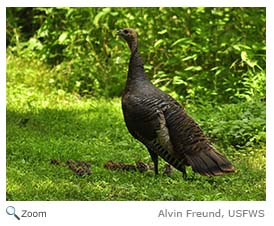 The wild turkey is one of only two North American birds that has been domesticated! The other is the Muscovy duck. By the end of the 19th century, the wild turkey had been hunted almost to extinction in much of its original range. Today, the wild turkey has been re-established in much of its original range. The wild turkey is one of only two North American birds that has been domesticated! The other is the Muscovy duck. By the end of the 19th century, the wild turkey had been hunted almost to extinction in much of its original range. Today, the wild turkey has been re-established in much of its original range.
If Benjamin Franklin had had his way, the wild turkey would have been the symbol of the United States instead of the bald eagle. He thought the wild turkey was more dignified than the eagle!
|